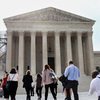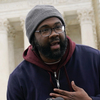The U.S. Supreme Court has used a vague legal idea known as the “Purcell principle” to justify delaying the redrawing of voting maps, which has forced some elections to use voting districts that lower courts found to be illegally drawn.
Mariam Zuhaib/AP
hide caption
toggle caption
Mariam Zuhaib/AP


The U.S. Supreme Court has used a vague legal idea known as the “Purcell principle” to justify delaying the redrawing of voting maps, which has forced some elections to use voting districts that lower courts found to be illegally drawn.
Mariam Zuhaib/AP
A closely watched U.S. Supreme Court ruling last month confirmed that Alabama voters cast ballots in illegally drawn voting districts for Congress in the 2022 elections.
There’s an obscure legal idea behind why the court allowed it to happen. It’s known as the “Purcell principle.”
To midterm voters in Alabama, its use by the Supreme Court meant that their ballots were cast in congressional districts that a lower federal court ruled — and the high court later confirmed — likely violated the Voting Rights Act as racial gerrymanders that dilute the power of Black voters.
This week, Alabama state lawmakers are gathering for a special session to approve new district lines for the U.S. House of Representatives — more than 17 months after the Supreme Court put on hold the January 2022 order by the lower court calling for the map to be redrawn before the midterm elections.
With references to the Purcell principle popping up in other federal court rulings in redistricting lawsuits, there’s growing concern among some election watchers about how the use of this vague legal concept is putting voters’ rights at risk.
What is the Purcell principle?
The idea is that federal courts should not make changes to voting rules close to an election in order to avoid confusing voters and election administrators.
And it comes out of a Supreme Court ruling in a case known as Purcell v. Gonzalez, a lawsuit about voter ID requirements that Arizona voters passed through a ballot proposition in 2004.
The high court, which later struck down part of the measure in 2013, was asked to weigh in on this legal challenge in 2006, when a federal appeals court temporarily blocked Arizona from enforcing the new voter ID rules close to five weeks before the last day of voting in that year’s general elections
After an emergency request by the state and a group of county officials, however, the Supreme Court threw out that lower court order, noting in an unsigned opinion:
“Court orders affecting elections, especially conflicting orders, can themselves result in voter confusion and consequent incentive to remain away from the polls. As an election draws closer, that risk will increase.”
The high court’s ruling was a “tremendous relief,” says Helen Purcell, the top election official at the time for Arizona’s Maricopa County who has become the namesake for the Purcell principle.
Purcell remembers feeling concerned about how a late change to the rules for the 2006 election could have befuddled voters and election offices.
“It’s mind-boggling when you’re thinking, ‘OK, how do I do this now?’ Because now the rules have been changed or the rule we thought was in place, we can’t use,” Purcell recalls.


Helen Purcell, the namesake of the Purcell principle and then-recorder for Maricopa County, Ariz., speaks at a news conference in Phoenix on Arizona’s 2016 presidential primary election.
Ryan Van Velzer/AP
hide caption
toggle caption
Ryan Van Velzer/AP


Helen Purcell, the namesake of the Purcell principle and then-recorder for Maricopa County, Ariz., speaks at a news conference in Phoenix on Arizona’s 2016 presidential primary election.
Ryan Van Velzer/AP
Looking back, Purcell says that ruling by the country’s highest court is a standout moment in a nearly three-decade career in running elections.
“You always think that if something is ultimately decided by the Supreme Court, that it is a big deal,” says Purcell, a Republican who lost a 2016 bid for reelection as the Maricopa County recorder. “But I didn’t think this was going to kind of take on a life of its own because it’s been used a number of times.”
Rick Hasen, a professor at UCLA School of Law who specializes in election law, has been keeping track.
Credited with coming up with the term “Purcell principle,” Hasen remembers first using it on his Election Law Blog in 2014. Federal courts have long been asked to weigh in on last-minute legal controversies about elections, Hasen explains, and the Purcell principle “kind of articulated a principle that maybe courts were considering in the background.”
How close to an election is too close?
In recent years, the Supreme Court has seen a growing number of requests for the justices to quickly issue orders, without getting fully briefed or hearing oral arguments, to resolve election-related disputes. These emergency applications are part of what court watchers call the “shadow docket.” Hasen says it’s given the justices more opportunities to decide when and how to weigh in on issues such as voter ID requirements and mail ballot deadlines.
The public, however, has gotten little insight into the court’s thinking about the Purcell principle because when the concept is explicitly referenced, it’s often in an opinion by a single justice or two that’s attached to an unsigned, unexplained court order.
A key question about the Purcell principle that the high court has yet to address publicly is exactly how close is too close to an election when a federal court is deciding whether election rule changes can go forward.
“The court has never defined how long that period is,” Hasen says. “But in the last few years, the court has seemed to apply the principle more broadly and for a longer period of time.”
How the Purcell principle allowed the use of illegal voting maps
In the case about Alabama’s congressional map, Allen v. Milligan, the Supreme Court offered no clarity on when it’s too close for a federal court to order a change to a redistricting plan before an election.
In February 2022, the high court issued no opinion by a majority of justices when it put a pause on a three-judge panel’s order and allowed Alabama to use a map approved by the Republican-led legislature that likely violated Section 2 of the Voting Rights Act.
But Justice Brett Kavanaugh, who was joined by fellow conservative Justice Samuel Alito, did release a concurring opinion that said the Purcell principle “reflects a bedrock tenet of election law: When an election is close at hand, the rules of the road must be clear and settled.”
Kavanaugh — who last year also cited the principle in an opinion for Moore v. Harper, another high-profile redistricting case — added that the court “has not yet had occasion to fully spell out all of its contours.”
Chief Justice John Roberts, however, said in a dissenting opinion that he believed the lower court’s ruling in the Alabama case should “control the upcoming election.” And Justice Elena Kagan, joined by the other two liberal justices on the court at the time, pointed out that unlike in the case Purcell v. Gonzalez, the last day of voting in an election was not weeks away.
In fact, when the three-judge court blocked Alabama from using the congressional map in January 2022, the start of absentee voting for the primary elections was more than two months away. The last day of primary voting, when most voters would head to the polls, was four months away.
And there was enough time to draw a new map, the three federal judges concluded. They ordered the state to push back candidates’ qualification deadline by two weeks to give the state legislature that extra time to come up with a new congressional redistricting plan. As the judges saw it:
“Based on the evidentiary record before us, we are confident that the Legislature can accomplish its task: the Legislature enacted the Plan in a matter of days last fall; the Legislature has been on notice since at least the time that this litigation was commenced months ago (and arguably earlier) that a new map might be required; the Legislature already has access to an experienced cartographer; and the Legislature has not just one or two, but at least eleven illustrative remedial plans to consult, one of which pairs no incumbents.”
If any of the Supreme Court justices were wary of confusing voters, it’s difficult to square that concern with the fact that maps across the country were being redrawn anyway after the 2020 census, notes Wilfred Codrington III, an associate professor of law at Brooklyn Law School who has written about the Purcell principle.
“We were starting with a blank slate in terms of congressional maps, and the new maps, whatever they were, couldn’t be confusing because they weren’t implemented yet,” Codrington says.
Still, it appeared that how the high court handled the Alabama case had set a precedent. More than four months later, the court blocked a similar lower court ruling about Louisiana’s congressional map, allowing another map that likely diluted the power of Black voters to be used in last year’s midterm elections.
Lower courts took heed of what the Supreme Court was doing.
U.S. District Judge Steve Jones found that Georgia’s congressional and state legislative redistricting plans likely violated Section 2 of the Voting Rights Act by minimizing Black voting power. But Jones also said that “it would be unwise, irresponsible, and against common sense for this Court not to take note” of the Supreme Court’s order in the Alabama case, as well as Kavanaugh’s opinion, so the judge ultimately ruled that those plans can be used for the midterms “because changes to the redistricting maps at this point in the 2022 election schedule are likely to substantially disrupt the election process.”
“A vote delayed is a vote denied”
Delaying the redrawing of voting maps to replace ones that courts say a trial would likely conclude to be discriminatory takes away voters’ right to vote in an equitable way, says Gilda Daniels, a former deputy chief in the voting section of the Justice Department’s Civil Rights Division who now teaches at the University of Baltimore School of Law.
“A vote delayed is a vote denied,” Daniels says. “You can’t get in a time machine and go back and say, ‘OK, you now have an additional district. Now vote under this fair and equitable map, this nondiscriminatory map.’ “
There are also implications on the balance of power in Congress, Codrington of Brooklyn Law School notes, when, in keeping with the Purcell principle, courts allow disputed maps that omit districts where Black voters have a realistic opportunity to elect candidates of their choice — likely Democrats.
The emphasis on federal courts not weighing in during an undefined period before an election runs the risk of partisan lawmakers and other political actors trying to manipulate the principle, Codrington adds.
“Another way of putting it might be, you get one election free no matter how illegal your election rule might be,” Codrington says.
Hasen of UCLA, who has long called for the Supreme Court to give fuller explanations whenever it invokes the Purcell principle, says he does see one “positive development” from Kavanaugh.
In his opinion for the Alabama case, the justice said that when considering emergency requests regarding late changes to elections, the principle is “not absolute” for federal courts, but it should be a high priority that is weighed against other factors, including whether it’s “entirely clearcut” that the plaintiffs bringing the lawsuit are likely to win and whether there would be “irreparable harm.”
“The factor that voters and election administrators might be confused and have trouble with election changes just before an election, that’s a perfectly valid concern, and I share that concern,” Hasen says. “The problem with Purcell is not that this is a factor. The problem is that it is the most important factor.”
Edited by Benjamin Swasey
This story originally appeared on NPR





